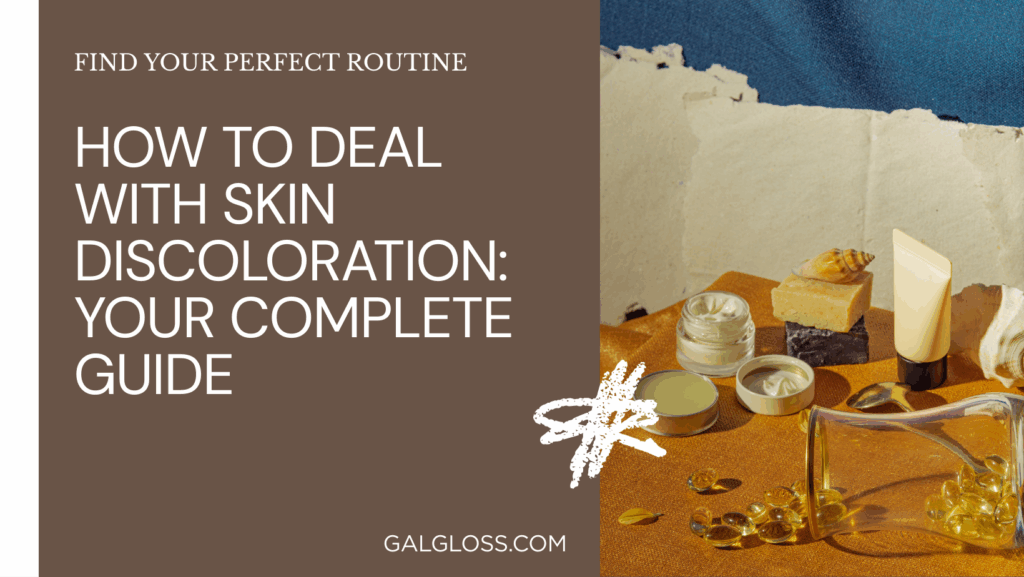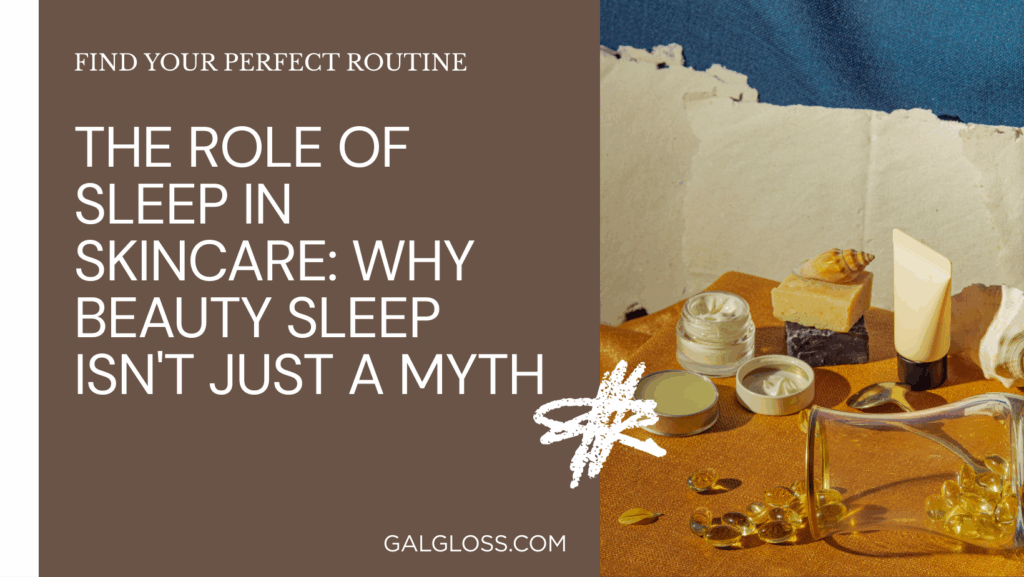Ever looked in the mirror and noticed patches of skin that don’t quite match the rest? You’re not alone. Skin discoloration is a common concern that affects people of all ages and skin types. But don’t worry – we’ve got you covered!
In this post, we’ll dive into the world of skin discoloration, exploring its causes, types, and most importantly, how to deal with it. Whether you’re battling dark spots, uneven skin tone, or mysterious patches, we’ll equip you with the knowledge and tools to tackle this pesky problem head-on.
So, ready to say goodbye to those mismatched skin tones and hello to a more radiant you? Let’s get started!
What is Skin Discoloration?

Picture your skin as a canvas. Now imagine some areas of that canvas suddenly deciding to go rogue with their color palette. That’s essentially what skin discoloration is – patches of skin that are either darker or lighter than your natural skin tone.
But why does this happen? Well, it’s all about melanin – the pigment that gives our skin its color. When melanin production goes haywire, you end up with areas that look different from the rest of your skin.
Types of Skin Discoloration
Let’s break down the main types of skin discoloration you might encounter:
- Hyperpigmentation: This is when patches of skin become darker than the surrounding areas. It’s like your skin decided to overachieve in the tanning department.
- Hypopigmentation: The opposite of hyperpigmentation, this is when patches of skin become lighter than your natural skin tone. Think of it as your skin taking a vacation from producing melanin.
- Melasma: Often called the “mask of pregnancy”, melasma causes brown or grayish-brown patches, usually on the face. It’s like your skin decided to play connect-the-dots without your permission.
- Age spots: Also known as liver spots or sun spots, these are small, dark areas that appear on skin exposed to the sun. They’re basically your skin’s way of keeping a diary of your sun exposure.
- Vitiligo: This condition causes the skin to lose its pigment cells, resulting in white patches. It’s as if your skin decided to go on a pigment strike.
Causes of Skin Discoloration
Now that we know the types, let’s explore what might be causing your skin to change its hue:
- Sun exposure: The sun is a major culprit when it comes to skin discoloration. Those UV rays can trigger excess melanin production, leading to dark spots and uneven skin tone.
- Hormonal changes: Pregnancy, birth control pills, and other hormonal fluctuations can lead to melasma and other forms of hyperpigmentation.
- Inflammation: Acne, eczema, or any skin injury can lead to post-inflammatory hyperpigmentation. It’s your skin’s way of leaving a “remember me” note.
- Medical conditions: Some health issues like Addison’s disease or hemochromatosis can cause skin discoloration.
- Medications: Certain antibiotics, anti-seizure drugs, and chemotherapy treatments can affect your skin’s pigmentation.
Prevention Strategies
As the old saying goes, prevention is better than cure. Here are some strategies to keep skin discoloration at bay:
Sun Protection
The sun is both a friend and foe to our skin. While we need some sun exposure for vitamin D, too much can lead to discoloration. Here’s how to protect yourself:
- Use a broad-spectrum sunscreen with at least SPF 30 daily, even on cloudy days.
- Wear protective clothing like wide-brimmed hats and long-sleeved shirts.
- Seek shade, especially between 10 a.m. and 4 p.m. when the sun is strongest.
Healthy Lifestyle Habits
Your skin is a reflection of your overall health. To keep it in top shape:
- Stay hydrated by drinking plenty of water.
- Eat a balanced diet rich in antioxidants, vitamins, and minerals.
- Get enough sleep to allow your skin to repair and regenerate.
- Manage stress through relaxation techniques or exercise.
Skin Care Routine
A good skincare routine can work wonders in preventing skin discoloration:
- Cleanse your face twice daily to remove dirt and excess oil.
- Exfoliate once or twice a week to remove dead skin cells.
- Use a moisturizer to keep your skin hydrated and healthy.
- Include products with ingredients like vitamin C, niacinamide, or alpha-arbutin to help even out skin tone.
Treatment Options
If prevention didn’t work and you’re already dealing with skin discoloration, don’t fret. There are several treatment options available:
Over-the-Counter Treatments
These are easily accessible and can be effective for mild cases of discoloration:
- Hydroquinone: This ingredient works by blocking the enzyme responsible for melanin production. It’s like putting your skin’s color factory on pause.
- Kojic acid: Derived from fungi, kojic acid inhibits melanin formation. Think of it as nature’s skin lightener.
- Vitamin C serums: These not only brighten skin but also provide antioxidant protection. It’s like a shield and brightener in one!
- Retinoids: These vitamin A derivatives promote cell turnover, helping to fade dark spots over time.
Prescription Medications
For more stubborn cases, your dermatologist might prescribe:
- Higher concentrations of hydroquinone
- Tretinoin (a stronger retinoid)
- Corticosteroids (for certain types of hyperpigmentation)
Professional Treatments
Sometimes, you need to bring in the big guns. Professional treatments include:
- Chemical peels: These remove the top layer of skin, encouraging new, evenly pigmented skin to grow.
- Microdermabrasion: This treatment gently sands your skin to remove the uneven outer layer.
- Laser therapy: Different types of lasers can target pigment cells without damaging the skin’s surface.
- Intense Pulsed Light (IPL): This treatment uses light energy to target pigment cells.
Natural Remedies
If you prefer a more natural approach, consider these options:
- Aloe vera: Known for its healing properties, aloe can help reduce hyperpigmentation.
- Licorice extract: This natural skin lightener can help even out skin tone.
- Green tea: Rich in antioxidants, green tea can help protect against sun damage and reduce inflammation.
When to See a Dermatologist
While many cases of skin discoloration can be managed at home, there are times when you should consult a professional:
- If your discoloration appears suddenly or spreads rapidly
- If it’s accompanied by other symptoms like itching or pain
- If over-the-counter treatments aren’t working after several weeks
- If you’re unsure about the cause of your discoloration
A dermatologist can provide a proper diagnosis and recommend the most effective treatment plan for your specific case.
Living with Skin Discoloration
Dealing with skin discoloration isn’t just about treatment – it’s also about learning to live confidently with your skin:
Makeup Tips
Makeup can be a great tool for concealing discoloration while you’re treating it:
- Use a color-correcting concealer before your foundation
- Choose a foundation that matches your natural skin tone
- Set your makeup with a translucent powder for longer-lasting coverage
Building Confidence
Remember, skin discoloration is incredibly common and doesn’t define your beauty:
- Focus on your overall health and well-being
- Surround yourself with supportive people
- Consider joining support groups or forums for people with similar skin concerns
- Remember that diversity in skin tones and appearances is natural and beautiful
Conclusion
Dealing with skin discoloration can feel like a bumpy road, but remember – you’re not alone on this journey. From sun protection to advanced treatments, there are numerous ways to address this common skin concern.
The key is to be patient and consistent with your chosen treatment plan. Results won’t appear overnight, but with time and care, you can achieve a more even skin tone. Remember, what works for one person might not work for another, so don’t be afraid to try different approaches or consult with a dermatologist.
Most importantly, while you’re working on evening out your skin tone, don’t forget to love and appreciate your skin as it is. After all, it’s been protecting you your whole life – a few spots here and there are just part of its unique story.
So, whether you’re dealing with hyperpigmentation, melasma, or any other form of skin discoloration, keep your chin up and your sunscreen on. With the right approach and a positive attitude, you can face the world with confidence, regardless of what your skin decides to do. Here’s to embracing your skin’s journey and glowing from the inside out!





